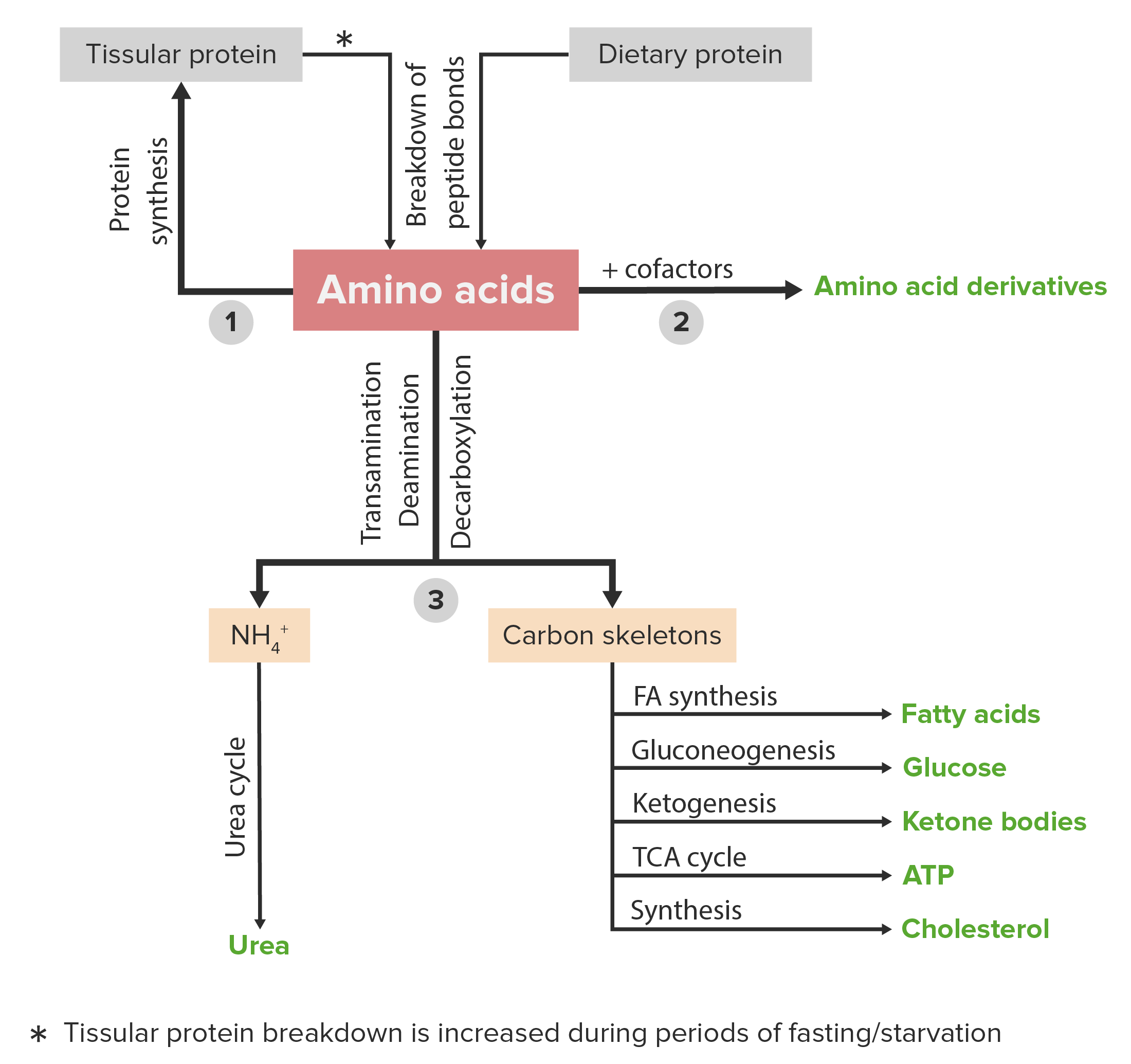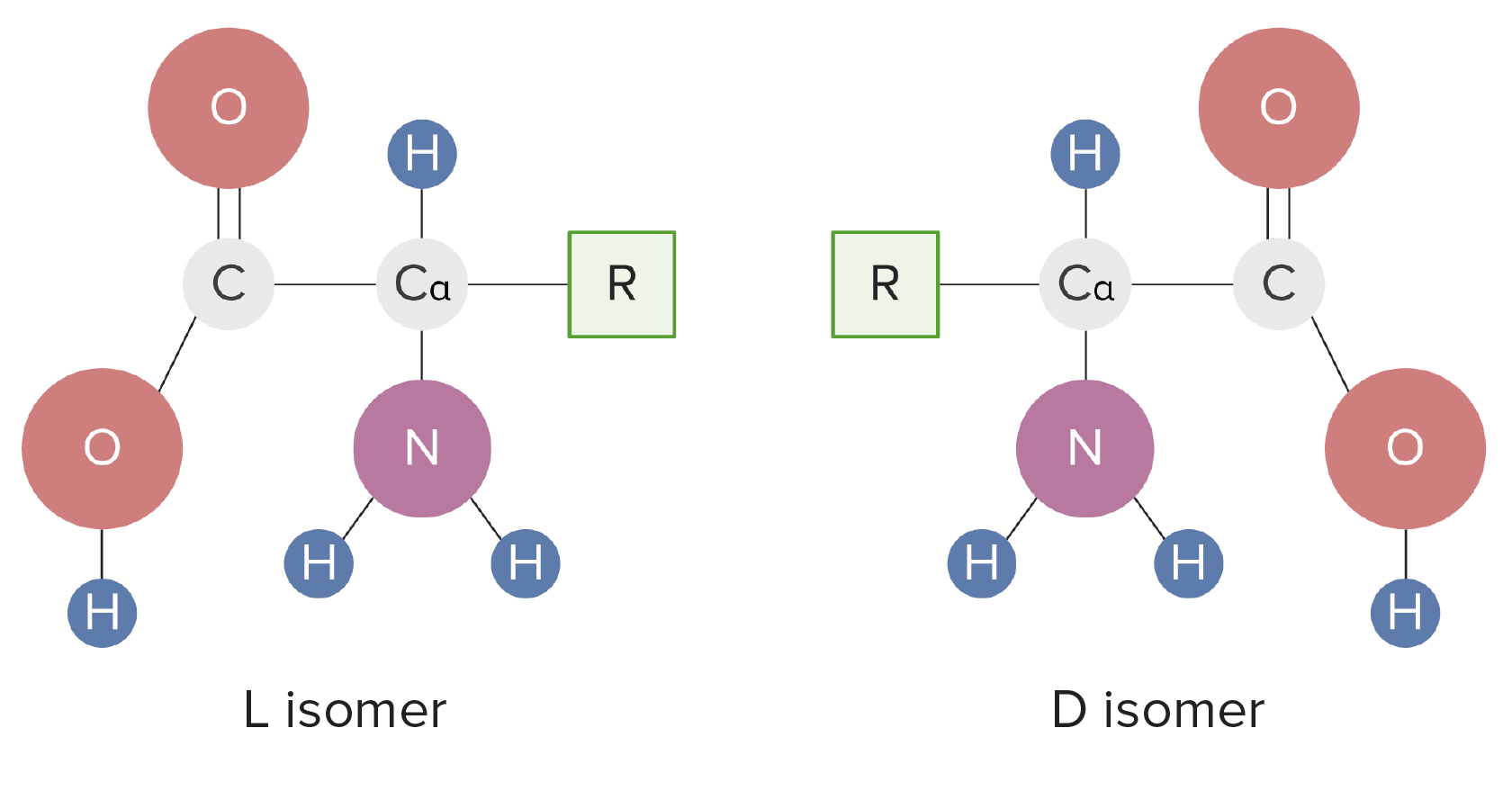Playlist
Show Playlist
Hide Playlist
Proline and Arginine Synthesis
-
Slides AminoAcidMetabolism Biochemistry.pdf
-
Reference List Biochemistry.pdf
-
Download Lecture Overview
00:01 That next amino acid we consider in biosynthesis is that a proline. 00:06 Proline is made in a relatively simple fashion in three steps starting from glutamate. 00:11 The first step involves the synthesis of glutamate-5-semialdehyde which I don't show here. 00:17 The first step beyond that then is the phosphorylation of the glumate-5-semialdehyde. 00:23 That oxidation and dephosphorylation is necessary to produce the cyclization intermediate. 00:28 And that's what we see on the screen below. 00:31 The cyclization that happens of glutamate-5-semialdehyde is spontaneous and does not require an enzyme. 00:37 We can see that cyclization actually happening to make one pyrroline-5-carboxylic acid. 00:43 Cyclization happens without any other thing being present in the reaction. 00:47 The last step that one pyrroline-5-carboxylic acid gets reduced and the reduction of that produces the amino acid proline. 00:56 Arginine is an amino acid that can be made in multiple ways. 01:00 In arginine, as we will see in the urea cycle, is a very important sort of central enzyme for doing a variety of things. 01:07 So there four ways to make arginine and I'll describe them right here and then show you later how those reactions occur. 01:14 The first is a forward reaction that takes two steps coming from citrulline and ATP and aspartate. 01:20 That process occurs in the urea cycle in the normal direction of the urea cycle. 01:26 The second way of making arginine is production from asymmetric dimethyl arginine or ADMA. 01:32 This is a modified form of arginine that's found in proteins. 01:36 It differs from arginine in having a metal group and that metal group is put on to arginine after the protein is made. 01:43 To get ADMA, one has to break a protein down by using proteolysis and then ADMA is released. 01:50 So, ADMA is made into arginine after a protein has been broken down. 01:55 The third reaction for making arginine involves a reversal of a reaction of the urea cycle using the enzyme arginase. 02:03 This reaction involves the molecule known as ornithine and we'll see how that actually is produced. 02:09 The last way of making arginine is a reaction that involves nitric oxide. 02:13 This is reaction that is actually used to make nitric oxide in cells and it involves citrulline, nitric acid, and NADP. 02:20 So arginine is a central part of the urea cycle. 02:23 And remember that the function of the urea cycle is to produce urea for excretion because excess amines are problematic. 02:30 The cell has to be able to have arginine in order to do that. 02:34 The ADMA reaction that actually goes backwards to produce arginine interferes with the production of nitric oxide. 02:40 Nitric oxide is a very important signaling molecule that cells use. 02:45 So again, cells have to balance need for one molecule versus need for another in considering which pathway is used to make a molecule. 02:54 Arginine may play role in very important diseases involving cardiovascular disease, diabetes mellitus, erectile dysfunction and kidney disease. 03:02 So it's a very important amino acid. 03:05 Deficiency of the enzyme arginase is another important reaction to consider because it leads to the genetic disease known as argininemia. 03:15 And argininemia as we will see for other amino acids involves the accumulation of arginine and more importantly ammonium ions in the blood. 03:23 Thos ammonium ions as we can describe are toxic. 03:27 Well, in this set of slides, I want to show now the reactions that I've just described previously the four ways of making arginine. 03:36 We see arginine in the lower part of the screen and we see how it connects to these molecules that I've been describing. 03:42 We start with reaction number one which involved the production of arginine from citrulline reaction -- set of reactions that occurs in the urea cycle. 03:51 There are two steps as I've described. 03:53 The first step being a very energy-intensive step that involves the cleavage of ATP to make AMP plus two inorganic phosphate ions. 04:02 This reaction is central to making arginine in the urea cycle but it's a very energy-intensive reaction. 04:08 So cells again, are cautious in how much they use to do this. 04:12 In each of the reaction that I show here, the green arrows point in the direction of making arginine. 04:18 And we see that each reaction is reversible so there's an arrow pointing the other direction that can go on different circumstances. 04:26 Argininosuccinate which is a product of the first reaction is converted into arginine in the next step, and we can see that was the product of arginine for pathway number 1. 04:36 ADMA after approaching has been broken down can be demethylated to make arginine as we have seen. 04:42 And we also see that by starting with ornithine and urea and going upwards with the lost of water, we can make arginine. 04:50 Now, normally, this reaction as it occurs in the urea cycle involves the downward direction. 04:57 So, in order to make arginine, we have to actually reverse that reaction. 05:00 Normally, that's not a very common way of making arginine. 05:04 The last way of making arginine is also a reversal of a reaction that occurs in the cells and this involves the nitric acid signaling that I've described before. 05:12 If we make arginine using this pathway, we use nitric oxide. 05:18 And nitric oxide, as I said, is an important molecule for signaling. 05:21 So, cells are careful again in how much this reaction is moved to the right versus how much it's moved to the left. 05:28 This reaction is an oxidation and we can see the oxidation occurring as a result of the NAPD being converted into NAPDH.
About the Lecture
The lecture Proline and Arginine Synthesis by Kevin Ahern, PhD is from the course Amino Acid Metabolism. It contains the following chapters:
- Proline Synthesis and Arginine Synthesis
- Alpha-ketoglutarate Family
Included Quiz Questions
Which of the following is true regarding arginine?
- It is an important precursor of urea.
- It is produced by catalysis of arginase.
- It is made primarily of nitric oxide.
- There are six ways to make arginine.
Which of the following compounds is not produced directly from arginine? Select all that apply.
- Ammonia
- Nitric oxide
- Ornithine
- ADMA
Customer reviews
4,0 of 5 stars
| 5 Stars |
|
0 |
| 4 Stars |
|
1 |
| 3 Stars |
|
0 |
| 2 Stars |
|
0 |
| 1 Star |
|
0 |
Clear and Comprehensive explanation. Not too detailed but enough to understand.






